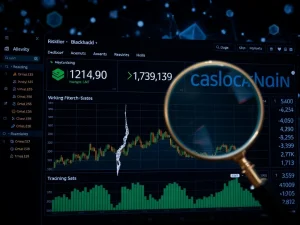Bitcoin Long-Term Holders: Unpacking Crucial On-Chain Metrics and Market Signals

The cryptocurrency market is a dynamic beast, constantly evolving and offering new insights into investor behavior. Right now, all eyes are on Bitcoin long-term holders, whose recent movements are sending fascinating signals across the ecosystem. Are these seasoned investors cashing out, or simply rebalancing their portfolios? The answer lies in key on-chain metrics that provide a window into the minds of those who’ve held Bitcoin through thick and thin.
Understanding Bitcoin Long-Term Holders’ Strategic Moves
In the world of Bitcoin, not all holders are created equal. Long-term holders (LTHs) are typically defined as addresses that have held their Bitcoin for more than 155 days. These are the diamond hands, the individuals or entities who have weathered multiple market cycles, often accumulating Bitcoin during dips and holding it through significant rallies. Their behavior is often seen as a bellwether for market sentiment, as their decisions can indicate whether the smart money believes the rally has more room to run or if it’s time to take profits.
Recently, a noticeable shift in the activity of these long-term players has captured the attention of analysts. While it’s natural for investors to realize gains during a sustained bull run, the current level of selling activity from LTHs is noteworthy. This isn’t just about volume; it’s about the age of the coins being moved, which carries significant economic weight and can influence Bitcoin price prediction models.
The Significance of the CDD Ratio and SOPR On-Chain Metrics
Two critical on-chain metrics are at the forefront of this discussion: the Monthly Cumulative Distribution Days (CDD) to Yearly CDD ratio and the Spent Output Profit Ratio (SOPR) for long-term holders (LTH-SOPR).
-
What is the CDD Ratio Telling Us?
The Coin Days Destroyed (CDD) metric measures the economic significance of coin movements. When a Bitcoin is held, it accumulates “coin days.” When it moves, these coin days are “destroyed.” A high CDD value indicates that older, more dormant coins are being moved, suggesting long-term holders are becoming active. The Monthly CDD to Yearly CDD ratio helps to contextualize this activity against a broader historical trend. A ratio reaching 0.25, as it has now, is particularly significant because it was previously observed during market peaks in 2014 and 2019. This level suggests that a notable portion of the supply held by experienced hands is being mobilized for sale, indicating heightened profit-taking.
-
SOPR: A Glimpse into Profit Realization
The Spent Output Profit Ratio (SOPR) is another powerful tool. It’s calculated by dividing the realized value (price sold) by the acquisition value (price bought) for all spent outputs. An SOPR value above 1 indicates that coins are being sold for a profit, while a value below 1 means they are being sold at a loss. When the SOPR for long-term holders (LTH-SOPR) surges to record highs, as it has in 2025, it unequivocally reflects elevated gains. This metric confirms that long-held coins are being sold at unusually high returns, underscoring the confidence these holders have in Bitcoin’s value retention, even as they take profits.
What Do These On-Chain Metrics Mean for Bitcoin Price Prediction?
While the increased selling from Bitcoin long-term holders might sound alarming, analysts are quick to caution against immediately calling a market top. The current situation presents a nuanced picture, with several factors at play:
- Moderate Transaction Volumes: Despite LTHs selling, overall transaction volumes remain moderate. This suggests that the market isn’t experiencing the kind of frantic, widespread distribution typically seen at a definitive market peak.
- Non-Excessive On-Chain Activity: Beyond CDD and SOPR, other on-chain indicators show that overall network activity isn’t excessively high. This implies that while some profit-taking is occurring, it’s not yet reaching the euphoric levels associated with a market overheating.
- Institutional Demand and ETF Inflows: A significant counter-force to LTH selling pressure is the sustained demand from institutional treasuries and continuous investment into Bitcoin ETFs. These large-scale inflows provide a robust demand floor, underpinning the rally’s momentum and absorbing some of the selling pressure.
- Divergence in Holder Behavior: The market is seeing a fascinating divergence. While LTHs are taking profits, short-term holders (STHs) remain relatively inactive. This indicates that the current rally isn’t primarily driven by speculative fervor from new entrants or quick traders, which often precedes sharp corrections. Instead, it’s a more measured environment where different investor cohorts are acting differently.
This dynamic illustrates a market driven by competing forces: profit-taking by established holders and sustained buying interest from institutional and retail investors. This complexity makes precise Bitcoin price prediction challenging, but it also suggests resilience.
Navigating Market Sentiment and Technical Analysis
Beyond the fundamental on-chain metrics, technical analysis adds another layer of understanding to Bitcoin’s current trajectory. Whale activity, often a precursor to significant price movements, and miner data are closely monitored. Some projections even suggest Bitcoin could test price levels around $131,000 if the bullish momentum persists, potentially even reaching $138,000 without showing signs of overheating. However, these ambitious forecasts are contingent on the consistency of whale accumulation and the continued health of on-chain metrics.
Short-term holder indicators, which often reflect the sentiment of newer or more speculative traders, currently remain within historical volatility ranges. This reinforces the idea that while LTHs are realizing gains, the broader market isn’t yet in a state of irrational exuberance, which could be a positive sign for sustained growth rather than a sharp peak.
Broader Implications and The Road Ahead for Bitcoin
The broader implications for the crypto market remain uncertain, but the current signals offer a blend of caution and optimism. While high SOPR values have historically correlated with market tops, experts emphasize that this single metric is insufficient to confirm a peak. The critical question for Bitcoin’s trajectory in the coming months is whether Bitcoin long-term holders will shift from their current profit-taking phase back into an accumulation phase. A return to accumulation by these experienced investors would signal strong conviction and could dictate a further upward trend.
Optimism is fueled by Bitcoin’s robust fundamentals, including its increasing adoption, network security, and growing institutional acceptance. The continued influx of capital into Bitcoin ETFs, which provide an accessible avenue for traditional investors, further strengthens this positive outlook. Some analysts even forecast a breakthrough above $123,000, driven by this persistent demand.
However, the persistence of profit-taking activity suggests caution is warranted. Prolonged selling, even if it doesn’t halt the rally entirely, could certainly slow its pace. Investors should continue to monitor these key on-chain metrics, institutional flows, and broader market sentiment to make informed decisions.
In conclusion, the current landscape of Bitcoin is a fascinating interplay of forces. Bitcoin long-term holders are taking significant profits, a move historically associated with market peaks, as evidenced by the CDD ratio and SOPR reaching critical levels. Yet, robust institutional demand and a lack of excessive speculative activity suggest the rally might still have legs. The coming months will reveal whether these experienced holders transition back to accumulation, or if their selling signals a more profound shift in market dynamics. Staying informed with accurate on-chain metrics will be key to navigating this exciting phase of Bitcoin’s journey.
Frequently Asked Questions (FAQs)
Q1: What does it mean when Bitcoin long-term holders are selling?
A: When Bitcoin long-term holders (LTHs) sell, it typically means that experienced investors who have held their Bitcoin for extended periods (usually over 155 days) are realizing profits from their investments. This is often observed during strong market rallies as they capitalize on significant gains.
Q2: How do on-chain metrics like CDD and SOPR help us understand Bitcoin’s market?
A: On-chain metrics provide direct insights into the blockchain’s activity. The Coin Days Destroyed (CDD) ratio indicates the movement of older, dormant coins, signaling activity from long-term holders. The Spent Output Profit Ratio (SOPR) shows whether coins are being sold at a profit or loss. Together, these metrics help analysts gauge investor sentiment, profit-taking levels, and potential market shifts by observing the behavior of different holder cohorts.
Q3: Does high LTH SOPR always mean a market top is near?
A: While a high Long-Term Holder SOPR (LTH-SOPR) has historically correlated with market tops, it’s not a definitive standalone indicator. Analysts emphasize that other factors, such as overall transaction volume, the extent of short-term holder activity, and institutional demand, must also be considered. The current situation, for example, shows high LTH SOPR but also sustained institutional buying, suggesting the market may not be at an immediate top.
Q4: How does institutional demand impact Bitcoin’s price amid LTH selling?
A: Institutional demand, particularly through Bitcoin ETFs and corporate treasury investments, acts as a significant counter-force to selling pressure from long-term holders. These large-scale inflows provide a robust demand floor, absorbing the supply being sold and helping to underpin the rally’s momentum, preventing sharper corrections that might otherwise occur.
Q5: What should investors watch for next regarding Bitcoin long-term holders?
A: Investors should closely monitor whether long-term holders shift from their current profit-taking phase back into an accumulation phase. A renewed accumulation trend from LTHs would signal strong conviction and could indicate further upward momentum for Bitcoin. Additionally, watch for extreme distribution metrics (like CDD ratios exceeding 0.5) and significant changes in transaction volumes.









